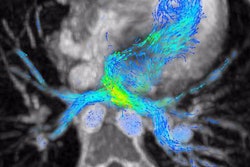
How are clinicians integrating 3D printing technology into adult cardiovascular medicine? Researchers from the U.S., Switzerland, and China detail a wide range of examples in four core areas in a review article published online October 21 in Interactive Cardiovascular and Thoracic Surgery.
"3D printing has expanded over the past three decades with growth in both facility implementation and diversity of medical applications," wrote the authors, led by Dr. Enrico Ferrari from Cardiocentro Ticino in Lugano, Switzerland. "The speed of technological development is increasing and the utility of 3D printing and its application in cardiovascular medicine is tangible."
Far and away the most common use of cardiovascular 3D printing has been to facilitate care for pediatric patients with congenital heart diseases, although the application of 3D printing in adult cardiovascular diseases also has been on the rise in recent years.
For the current review article, Ferrari and colleagues searched the Medline database for all available publications on adult cardiovascular 3D printing as of January 2019. The review included 130 3D-printed anatomical models used in the 58 studies examined.
The clinicians performing these studies most often relied upon CT scans to create 3D-printed aortas and aortic valves, whereas they generally used MRI for models replicating vasculature disorders and 3D transesophageal echocardiography for 3D-printed mitral valves and left atrial appendages.
After analyzing the studies, the researchers identified four central applications of adult cardiovascular 3D printing:
Procedural planning and decision-making: Collectively, the studies discussed numerous scenarios in which 3D-printed heart models helped clinicians plan surgical procedures. One scenario that repeatedly arose was using an individually tailored 3D-printed model of the aortic root and valve to simulate transcatheter aortic valve replacement.
Other common cases involved using 3D-printed models to study calcification patterns and valve hemodynamics in patients with severe stenosis, predict annulus ring size and determine the ideal type of leaflet resection before surgery, plan endovascular aortic repairs, and size devices for implantation into the left atrial appendage.
The patient-specific, tactile representation of cardiovascular anatomy in the 3D-printed models was helpful in planning and simulating numerous cardiovascular procedures, the authors noted.
- Medical education and training: Randomized studies have yet to demonstrate any statistically significant difference between 3D-printed and traditional 2D models in teaching cardiac anatomy and disease to students. However, 3D-printed hearts supply a means of simulating cardiac procedures, which is crucial for surgical training. Several studies highlighted the advantages of simulating transapical procedures on realistic 3D-printed models of the mitral valve and aortic root.
- Medical device development and testing: Scientists have developed various methods for generating 3D-printed physiological simulators of coronary blood flow, allowing for testing of transcatheter devices for aortic repair. Several groups have also used 3D printing technology to create left atrial appendage closure devices, aortic valve scaffolds, and, most recently, 3D-bioprinted cardiac tissue.
- Patient-physician communication: Finally, several studies discussed the benefits of using 3D-printed models to improve patient understanding of their condition during consultation.
Beyond 3D printing, other advanced imaging techniques have emerged as potential alternatives, such as virtual and augmented reality, fusion technology, and 4D imaging. Yet 3D printing has the distinct advantage of offering a tactile component to visualization, minimizing variation in visual-spatial skills among clinicians and patients, the authors noted.
"3D printing allows a heuristic approach to investigate complex cardiovascular diseases, and it is a unique patient-specific technology providing enhanced understanding and tactile representation of cardiovascular anatomies," they concluded.



















